ART AFRICA spoke with Tapfuma Gutsa on the occasion of the opening of ‘DAMBA NEPWERE’, his major new solo exhibition at First Floor Gallery, Harare.
Tapfuma Gutsa arrives, walking in with a walking staff carved loosely out of a branch, dressed in a tailored blue linen shirt and a navy waistcoat. His dress style is nothing if not on point regardless of the time of day or years passed. It is a hot afternoon in Harare and we are talking about an event that the Harare art community has been whispering about for months, his new exhibition!
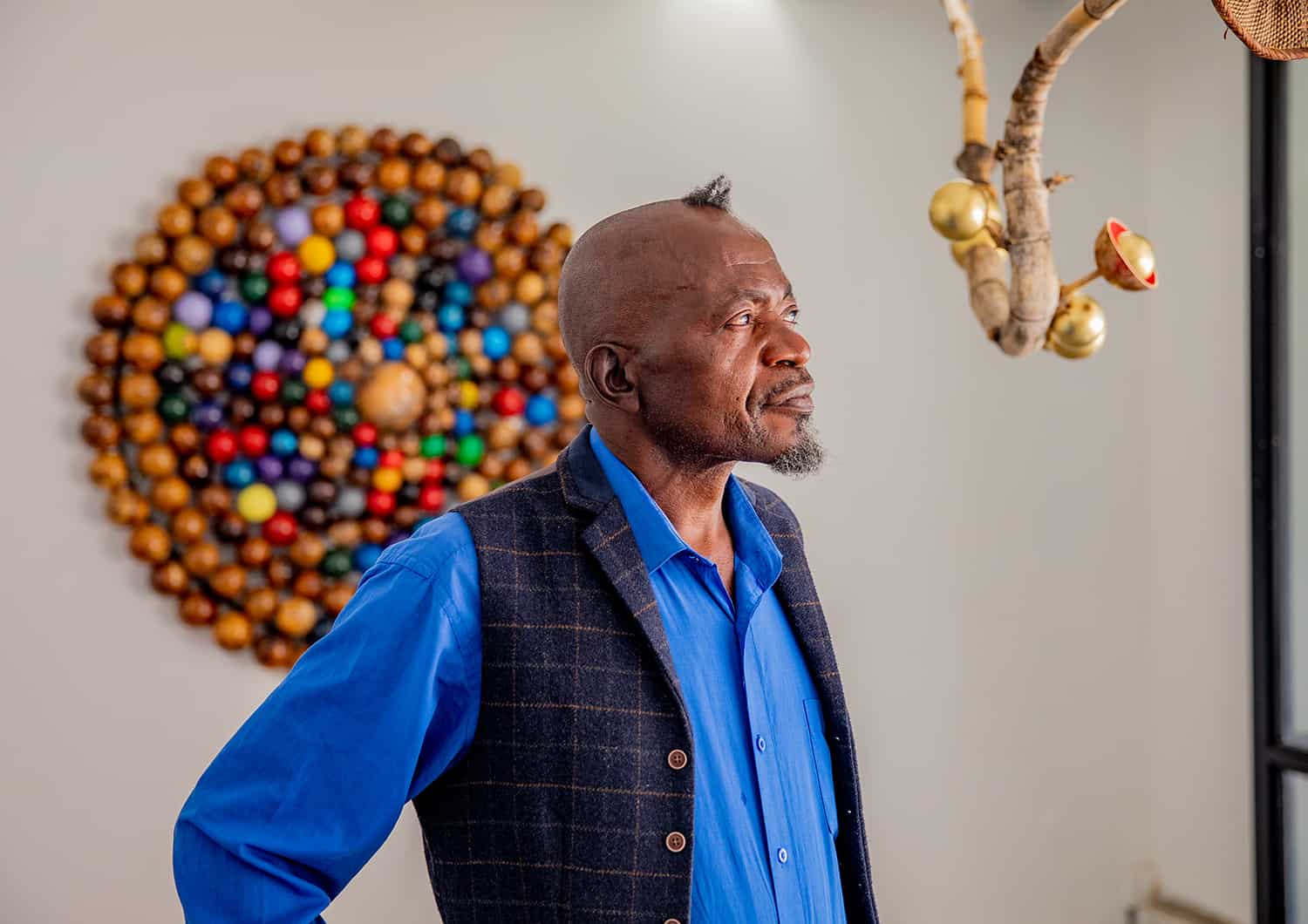
Tapfuma Gutsa
Whenever Gutsa speaks, it feels like the words have made a long journey to leave his mouth, a journey intellectual, emotional and historical. When they emerge, the words feel like they could be cut in stone – laconic and measured as they are spoken by a sculptor whose life has been accompanied by the rhythm of materials realizing their meaning in concrete form – a cutter hitting granite, spinning of the potter’s wheel, a reed bending and folding.
“Marechera once said that our rocks [in Zimbabwe] are giant’s playthings,” he says. “Uhm, we were friends,” he says looking far away, with a memory of the legendary author of House of Hunger and gone too young hero of Zimbabwean literature Dambudzo Marechera. And we are no longer here in the middle of a hot afternoon in Harare, we are somewhere in the space of what it means to be part of a land and a country and space occupied by torrential flows of history and the fragility and the resilience of artists who live it and make their claim to it.
This is the start of a conversation that resolves itself as Gutsa’s first new body of work in five years and emerges from a paradigm-shifting period that has forced the father of contemporary art in Zimbabwe to come back to his roots in Murehwa (90km North-East of Harare) rethink and rebuild his approach to practice and in some ways even a philosophy of life.
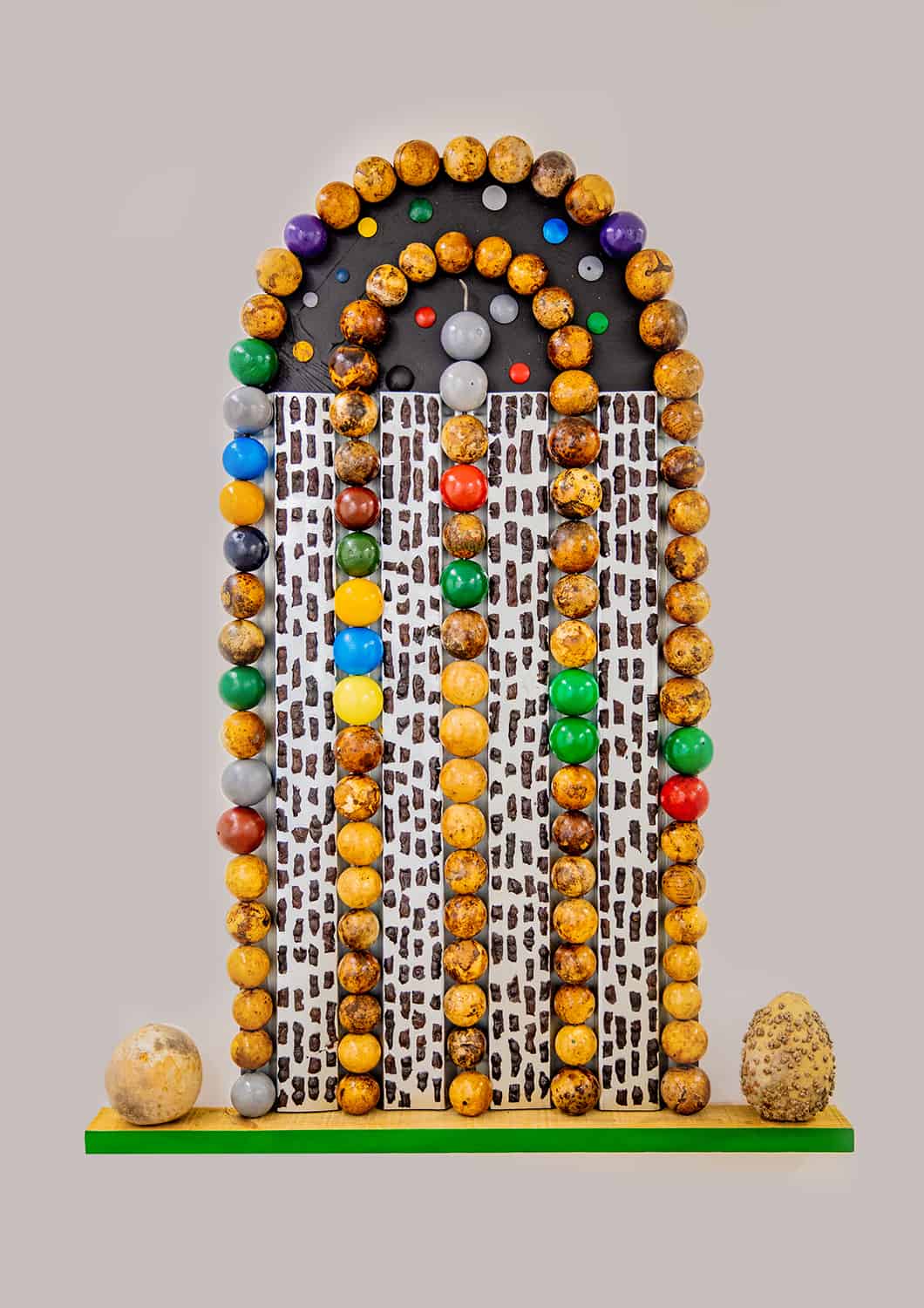
Kereke 2, Painted and polished Matamba, corrugated aluminium bark, wood and gourd, 168 x 125 x 15cm. All images courtesy of First Floor Gallery, Harare.
Like Marerchera, Gutsa’s has always occupied a heroic role in the art scene of Zimbabwe. When people say Tapfuma, there is only one that they are speaking of and when the younger artists speak they do not refer to him without the respectful prefix Sekuru. At once charismatic and enigmatic, Gutsa is in many ways beholden to his legend and that makes change risky for an artist. And yet risk is at the heart of all great art.
An artist above all he once famously said “The Western world has long borrowed from Africa. I find no problem in borrowing from them”. That freedom not to be beholden to something is a freedom to choose sincerely and articulate your values clearly. He has never tried or imagined that his Africanness needed to be demonstrated, it was and is a fact of his being and all the work that he makes regardless of how or why is African.
For Gutsa, in 2020, the risk is total honesty in his work. The new body of work has been a process of experimentation and rethinking of what it means to be an artist and a sculptor and an individualistic visionary, who now has to collaborate in order to realize his vision, who has to rethink his materials and tools entirely.
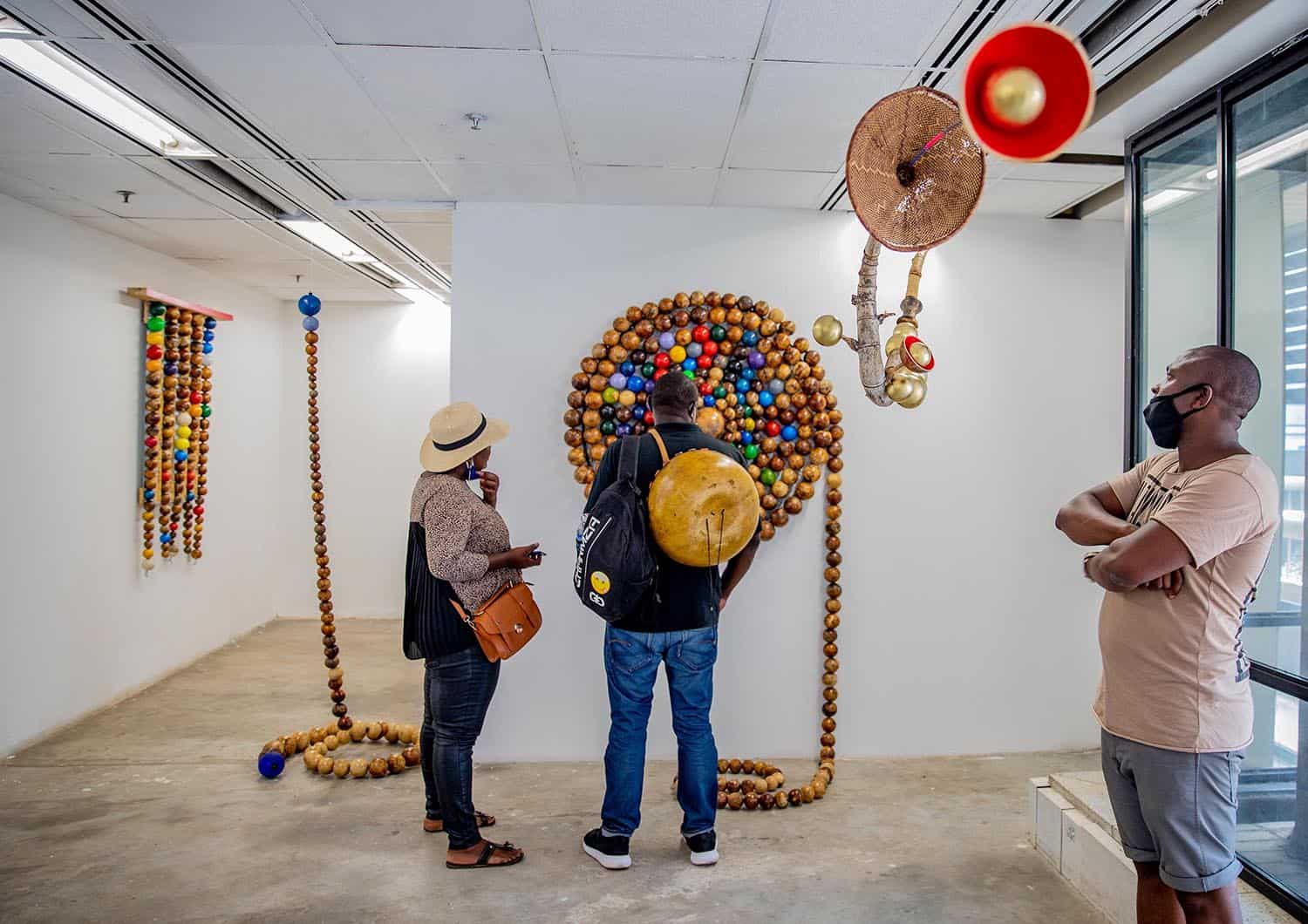
Visitors at Tapfuma Gutsa’s ‘Damba Nepwere’ exhibition opening.
Like Marechera, Gutsa left Zimbabwe for the UK in the 1980s to study and to build his career taking a leap of faith from Stone sculpture into contemporary art and achieving almost immediate international acclaim with institutional and gallery exhibitions around the world. Havanna Biennale, Cuba, Contemporary African Art, Studio Museum, Harlem New York City, the USA in 1990 and taking part in the 1991 Venice Biennale, African Pavilion a project curated by Grace Stanislaus; South Meets West a survey featuring Artists: Jane Alexander, South-Africa, Fernando Alvim, Angola, Meschac Gaba, Benin, Kendell Geers, South-Africa, Tapfuma Gutsa, Zimbabwe, Atta Kwami, Ghana, Goody Leye, Cameroon, Zwelethu Mthethwa, South-Africa, Tracey Rose, South-Africa, Yinka Shonibare, Nigeria, Pascale Marthine Tayou, Kamerun, Yacouba Touré, Elfenbeinküste, Minnette Vari, Südafrika, Dominique Zinkpe, Benin and Uncomfortable Truths: The Shadow of Slave Trading on Contemporary Art at Victoria & Albert Museum which was held in 2007 and featured among others El Anatsui, Romouald Hazumé, Lubaina Himi, Yinka Shonibare and Fred Wilson as well as Gutsa and which laid some of the key foundations for the reception of contemporary African art we are seeing today.
Gutsa lived to see his country wake up from the euphoria of independence to drama and trauma of economic crisis and political instability – the long and painful work of emerging from colonization intellectually, culturally and economically, which is still ongoing.
Unlike Marechera, Gutsa lived to see his country wake up from the euphoria of independence to drama and trauma of economic crisis and political instability – the long and painful work of emerging from colonization intellectually, culturally and economically, which is still ongoing. For Tapfuma this translated to a sense of social responsibility and paying it forward. Keenly aware of the importance of supporting emerging artists not just in Zimbabwe but across Africa and beyond. He was the first mentor and teacher to his now-famous cousin Dominic Benhura and his workshops done with the Triangle Network are legendary from Kenya to Mozambique and Botswana but also in Kingston, Jamaica where he did a workshop at Xayamaca in 1993. In the era when African avant-garde was just forming Gutsa was part of the legendary Pachipamwe International Art Workshop which brought together such incredible luminaries like Bill Ainslie, Sokari Douglas Camp, David Koloane, Adam Madebe, Bernard Matemera, Antonio Ole as well as Gutsa.
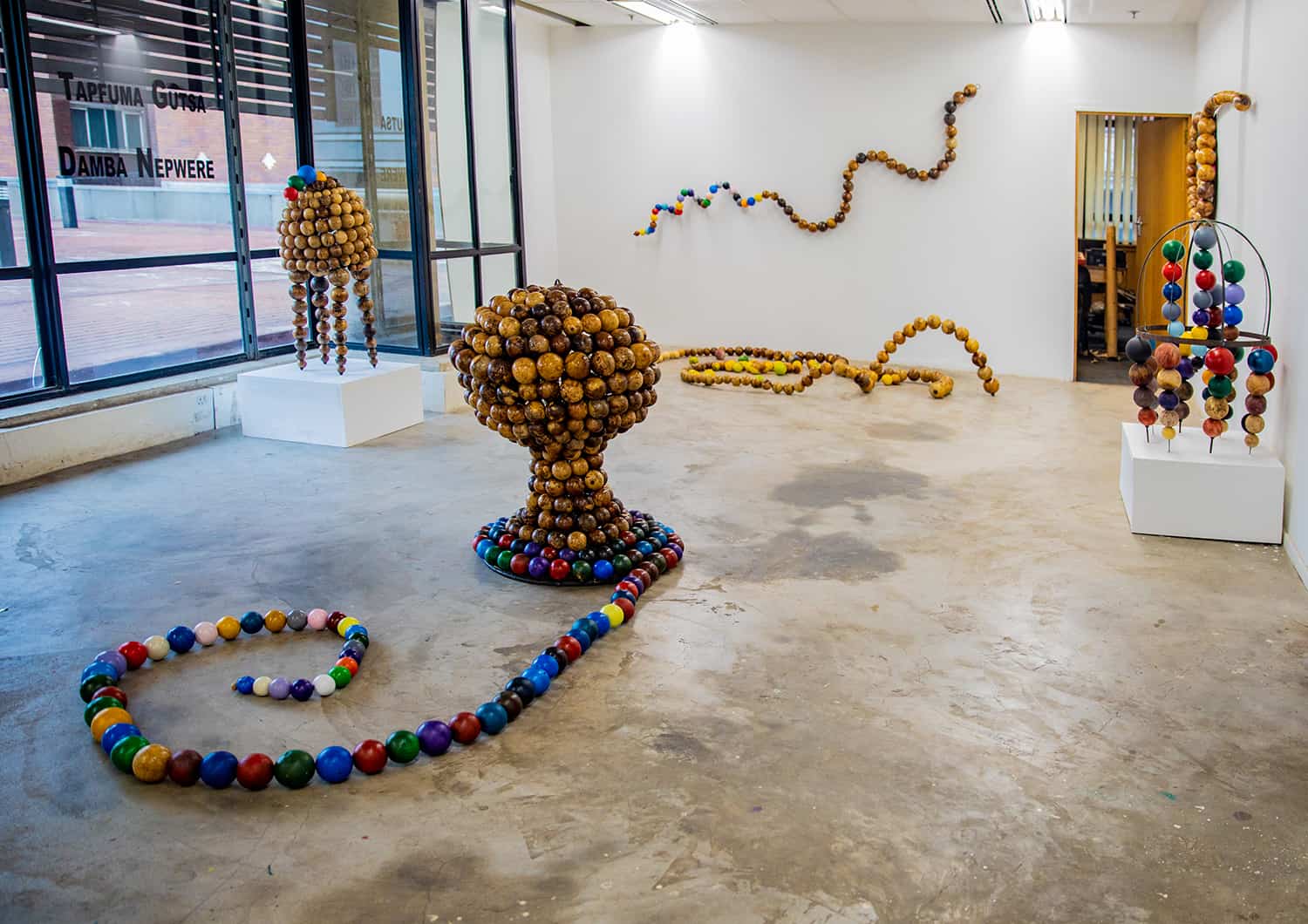
Installation view, Tapfuma Gutsa, ‘Damba Nepwere’.
When he returned to live permanently in Zimbabwe in 2009, Gutsa immediately became a de facto elder statesman of the art community. Joining the National Gallery of Zimbabwe as Deputy Director, he emerged as a treasured and beloved mentor to many at a time when Zimbabwe was emerging from a period of isolation and the trauma of hyperinflation crisis. His ‘Live and Direct’ exhibition in 2010, is widely regarded as a catalyst for the flourishing of contemporary art we are seeing today in Zimbabwe and featured young and experimental artists like Moffat Takadiwa, Wycliffe Mundopa, Gareth Nyandoro, Virginia Chihota, Portia Zvavahera and Misheck Masamvu. With Tapfuma back home, these and other young artists forged a commitment despite difficulties to remain in Zimbabwe rather than seeking greener pastures abroad – a commitment to elevating the pain of daily life to make great art.
…elements are easily discernable but cryptic nonetheless…
Damba nepwere, which translates as child’s toys, is presented as a play and a puzzle concordant with the title. The elements are easily discernable but cryptic nonetheless: the matamba shells, some painted in vibrant celebratory hues from pink to violet, orange, silver and gold and some scorched by the sun and fire; bark, leaves, wood. The elements assemble and mutate into different forms almost but never quite biomorphic, attempting to hint at the possibility of recognition but not yielding to it.
What ideas are at play in these organic yet highly considered formations?
This body of work celebrates play, colour, chance and intuition. The fruit first came into my art on a tribute to a friend, Brighton Sango, a brilliant and mercurial artist who sadly died very young. The work evokes his use of geometrical forms in his abstract sculptures punctuated by three raw matamba because the green fruit is very bitter. This heralded the use of modules found in nature to make one work with little alteration which can be seen in the Mulonga series two of which grace the American embassy in Zimbabwe. One thing led to others: spirally horn pieces as seen in the photographs and Lightning piece at the 2011 Venice Biennale, some jewellery pieces and Brancusi inspired columns that were colour coded. The spheres are also reminiscent of Crick and Watson’s work with DNA and of course the mammoth feat of the 20th century, the genome project. Therefore colour, the spiral and arabesque predominantly in this project especially after being diagnosed with severe eczema, a genetic disorder, in 2015 which nearly finished me off in 2019 after a severe flare-up.
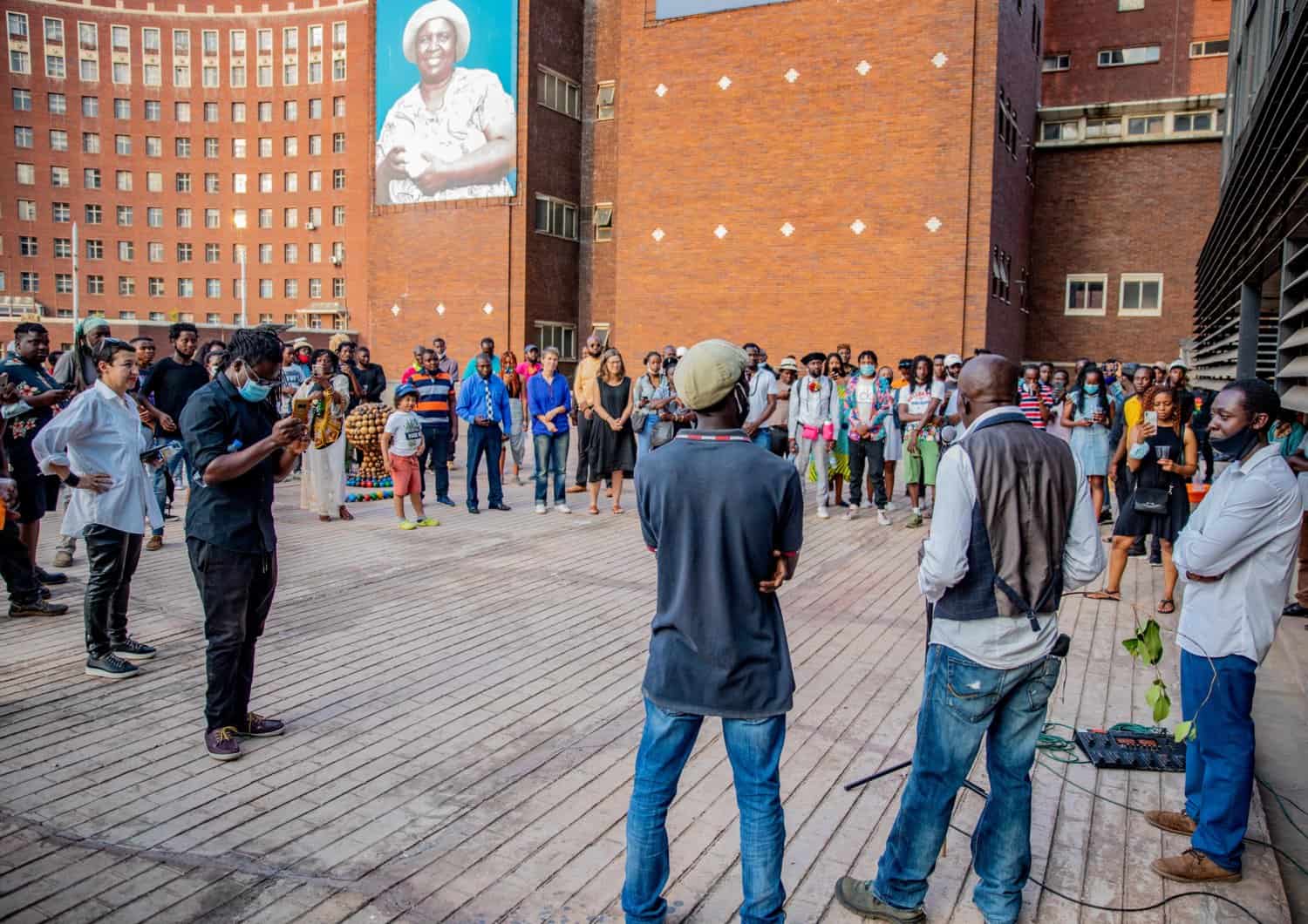
Guests on the terrace of First Floor Gallery, Harare at the opening of Tapfuma Gutsa’s exhibition ‘Damba Nepwere’.
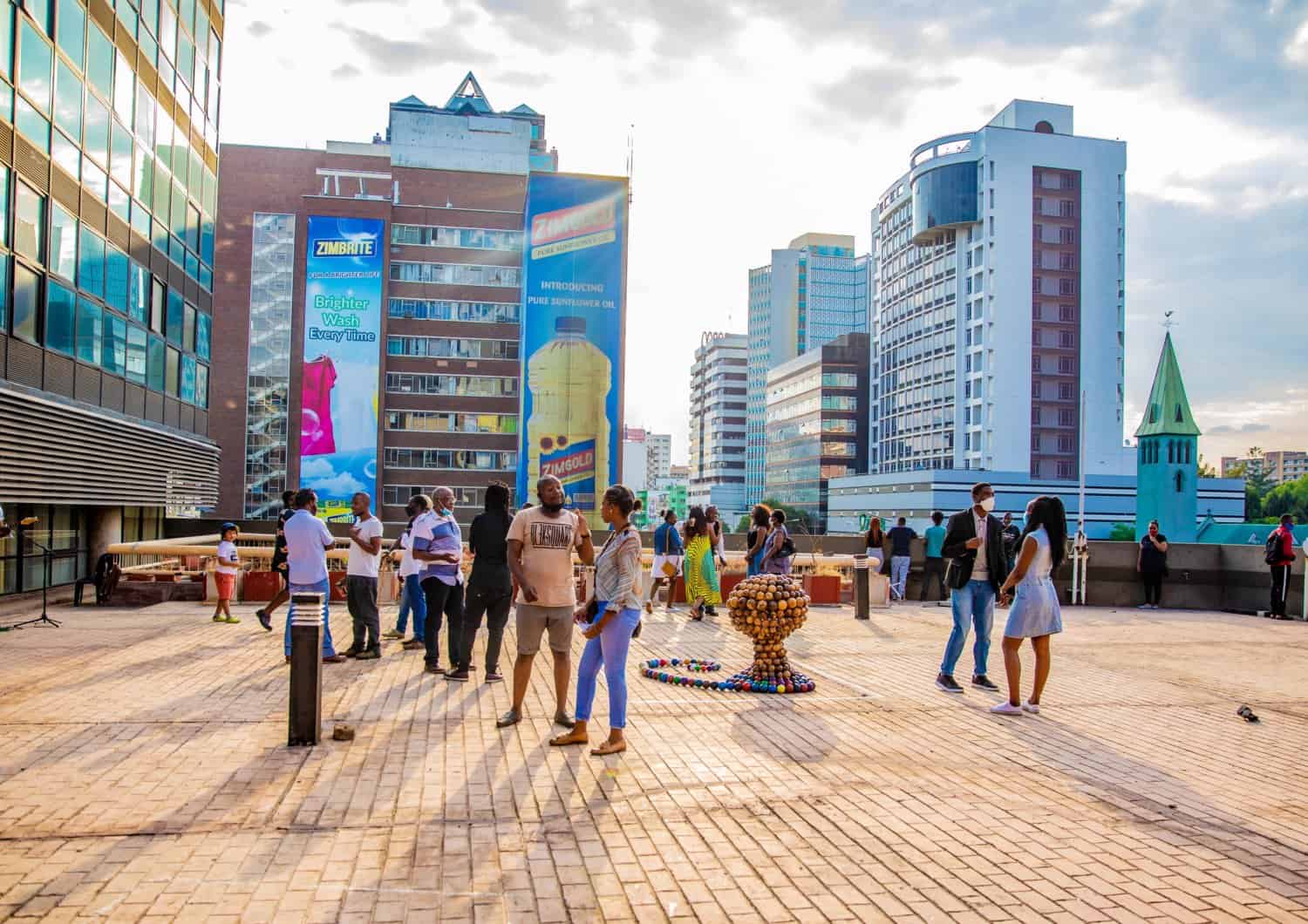
Guests on the terrace of First Floor Gallery, Harare at the opening of Tapfuma Gutsa’s exhibition ‘Damba Nepwere’.
The title is very metaphoric is it not?
I read a lot and came across Dambudzo Marechera’s book in which he irreverently refers to the unusual granite formation that dots the Zimbabwean landscape as ‘the giant child’s playthings. This became a working title. The phrase is a light take on massive and ponderous boulders of granite. Atlas comes to mind condemned to carry the world forever. Just as fateful are genes in humans and indeed all living organisms. Deities are ambivalent as seen in the machinations of Greek gods and the modern god. Gods paint lives differently, playfully inflicting and compensating on different projects creating variations of the same theme as in the nature of all human sub-species.
There is a sequence of works that look like gates and use corrugated iron, which stands apart from the very organic forms of the other work, how did that come about?
The works in progress called for a sorting table of corrugated iron akin to a jeweller’s sorting panel pre-empting shields, portals and windows recalling Motherwell’s windows, Caro’s portals and Tibetan mandala, an abacus for reckoning culminating in endless mutations and permutations. The work strives for poetic syntax and cadence balancing softness and hardness, Fragility and robustness, Chaos and regimentation that congeals in the one whole. Some of the work alludes to the skin, as in bark and eggshell, which is the active domain of eczema.
I feel that there is a defined progression and a narrative that you want to guide the viewer through, is that accurate?
That is definitely the intention. For example, the site piece consists of two arabesques that work best intertwined and placed in an isolated place hopefully inviting a wonderer to pose with a sense of arrival and wonder about the meaning, seeking clues of purpose and intentions of the creator sharing some arcane ritual or rite of passage. The possibility of possession, taking the pieces away with. The spheres a plain with some sanded down for contrast allowing them to blend with nature and eventually return to nature leaving their spines.
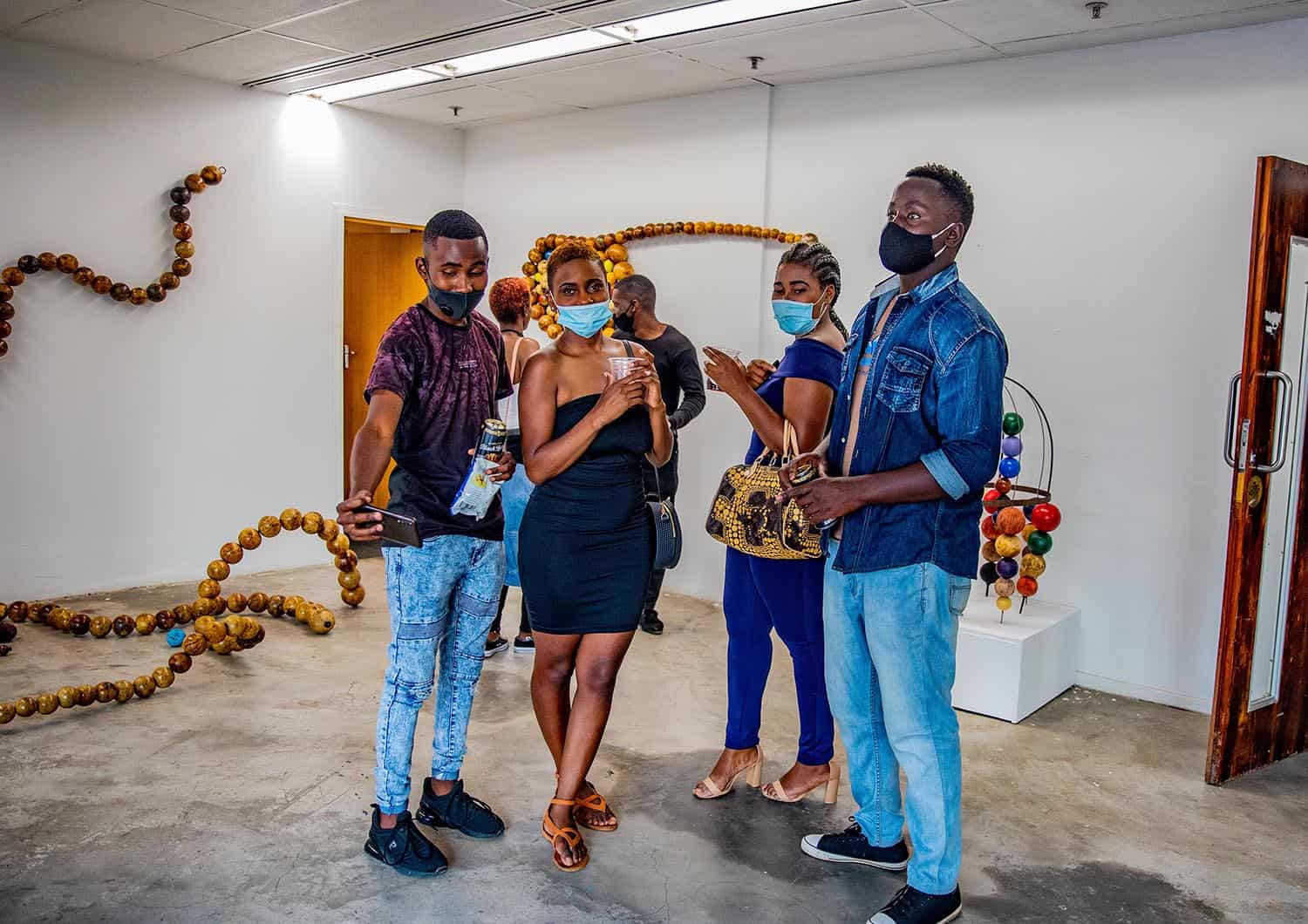
Guests at the opening of Tapfuma Gutsa’s ‘Damba Nepwere’ at First Floor Gallery, Harare.
So in a manner of speaking the work resolves itself towards philosophical reconciliation for you personally and more broadly with the human condition?
Reflections on life, death, destiny, fate, creation and genetics bristle for answers. It is now open knowledge that the Gutsa’s carry the eczema vector, further since family research started there are four known active cases and one recovery in the family. How do the genes and DNA configure to cause eczema in five out of hundreds of clansmen? How are the hundreds reprieved? Is there an active godlike consciousness making these fateful decisions? The genesis of the god idea opens itself to the discussion. Gods are known to inflict pestilence as in the Book of Job. Is creation, humans/toys included, in the thrall of a god/giant’s child? Latent cosmic intelligence at work, a constant gardener and prankster too. If so, then it’s obviously a man can impose god to wreak havoc with atomic that produce bizarre and absurdly beautiful mushroom clouds. The debate is endless but the only proven life eternal is of a progenitive nature.
The sun is setting and the exhibition is complete but the master is already planning new work!
“The tray of spheres is a virtual laboratory full of startling delight and subtle insights. Spring wanes promising summer and it’s time to gather building blocks before rain spoils them for new work: Matamba.”



